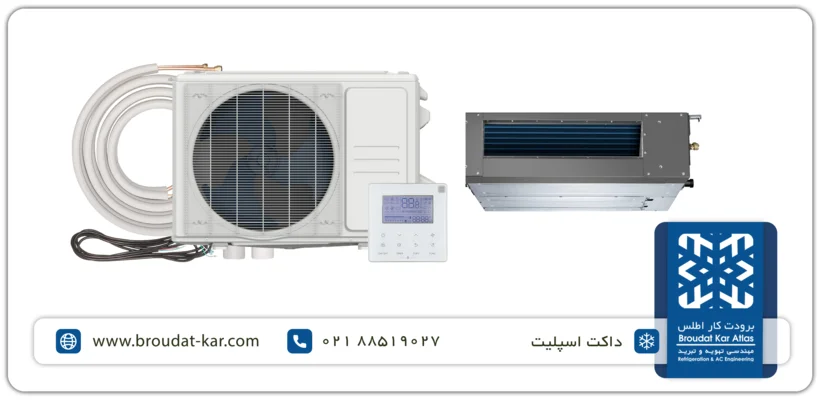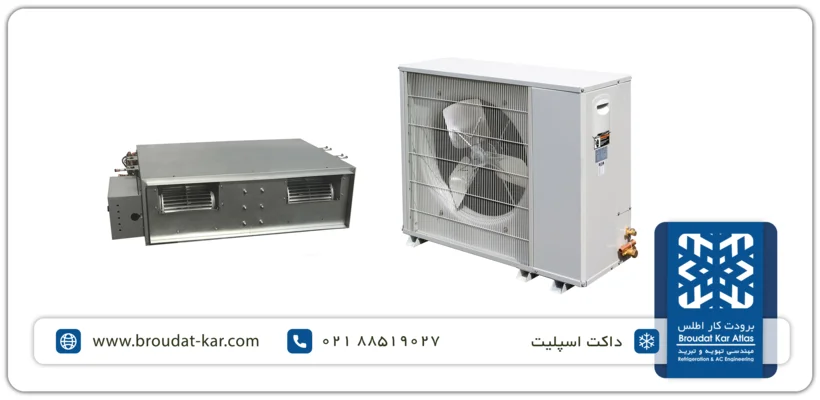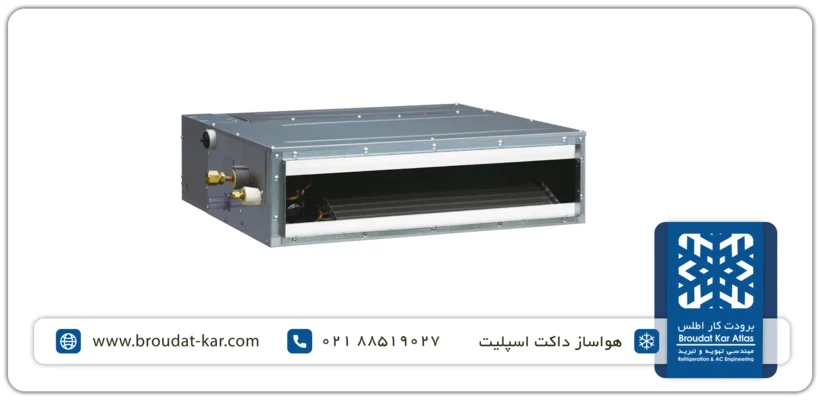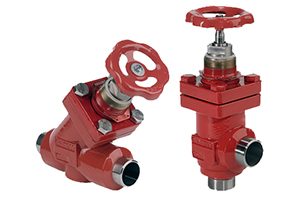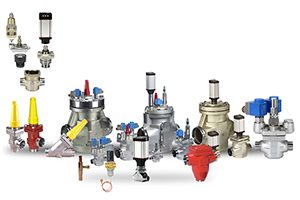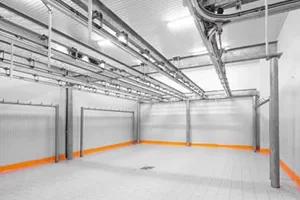What is Ducted Split?
A ducted split system, also known as a duct split, is an HVAC configuration that comprises an external condensing unit and an internal air handler. These components are interconnected by refrigerant pipes to provide both cooling and heating for indoor spaces.
Distinguishing Between Split and Split Duct Systems
The primary distinction between a split and a split duct lies in the installation method of the indoor unit. In a standard split system, the indoor unit is typically mounted directly on the wall or floor, circulating conditioned air directly within the room.
In contrast, a split duct system utilizes concealed air ducts within walls, ceilings, or floors to distribute air throughout the entire building space, including rooms, hallways, reception areas, and more.
“Split duct systems offer versatile heating and cooling capabilities, making them suitable for year-round use.”
Key Components of a Split Duct System
The split duct system comprises several essential components, including:
- Outdoor Unit: The outdoor unit houses the compressor and condenser, responsible for compressing and liquefying the refrigerant.
- Indoor Unit: Concealed within the ceiling or attic space, the internal unit connects to ducts that distribute air throughout the room.
- Ducting: A network of channels delivers fresh air to various areas or rooms, designed to minimize noise.
- Vents: Located in the ceiling, walls, or floor, vents facilitate airflow into the space, with the air return channel integral to the system.
- Remote Control: Equipped with a remote control, users can adjust temperature, fan speed, and operation mode for optimal comfort and efficiency.
Technical Specifications of BDS Model Ducted Split
– Utilizes reliable compressor brands, including scroll and piston, tailored to capacity requirements.
– Features a Direct Expansion Cooling Coil (DX) designed for low capacities.
– Incorporates an efficient hot water heating oil within the device.
– Constructed with a galvanized sheet body and electrostatic powder coating for durability.
– Equipped with easily accessible washable filters for maintenance convenience.
– Suitable for residential, office, and commercial spaces with multiple zones.
– Allows easy access to internal components for periodic servicing.
– Complete insulation both internally and externally, including the drain tray.
– Includes a sand-blasted receiver tank with service valve for efficient operation.
– Standard chassis design utilizing bent sheet and screw connections.
– Utilizes condenser coils made of standard copper tubes and sinusoidal fins for air-cooled models, and shell and tube configuration with machined plates for water-cooled models.
– Mechanical and electrical control equipment sourced from reputable European brands.
Customization of specifications and brands available upon request.
A ducted split system consists of both an indoor and an outdoor unit, connected by piping and ducts that distribute conditioned air throughout different rooms or areas. It provides both cooling and heating functions.
Ducted Split Features
– Economical and modern air conditioning solution offering both cooling and heating capabilities.
– Evenly distributes air throughout a space via hidden channels in the ceiling, ensuring uniform temperature control.
– Utilizes advanced technologies such as inverter compressors to adjust speed based on cooling or heating requirements, resulting in reduced energy consumption and lower electricity costs.
– Equipped with user-friendly thermostats and remote-control options for convenient temperature and timing adjustments, allowing precise ventilation control.
– Eliminates vertical channels of traditional water coolers, optimizing building space and enhancing aesthetic appeal.”
Duct Split, also known as Ducted Split, comprises two main units: indoor and outdoor. These units are interconnected via piping and ducting within a structure, facilitating the distribution of conditioned air across various rooms or zones. Duct Split systems are versatile, providing both cooling and heating functionalities.
How Ducted Split Systems Operate
When we turn on a ducted split, the concealed indoor unit in the ceiling or attic initiates operation. It draws warm air from the interior via return air ducts. The device’s fan then circulates this warm air over the cooling coil within the indoor unit. This cooling coil contains refrigerant, which evaporates upon contact with the warm air, absorbing its heat and subsequently cooling the air.
The conditioned air is then distributed throughout the indoor space via supply air ducts connected to the indoor unit. Meanwhile, the external unit, functioning as the condensing unit, provides refrigerant liquid to the system, transferring the heat from the indoor air to the outdoor environment. Temperature and fan speed can be conveniently controlled via remote control.
Advantages of Ducted Split Systems
– Aesthetic Integration: Ducted split systems offer built-in installation, with the indoor unit concealed in the ceiling or attic space. This design enhances interior aesthetics compared to visible wall or floor units.
– Even Air Distribution: Engineered for uniform airflow, split duct systems ensure consistent temperatures throughout the space. By eliminating hot and cold spots, they create a more comfortable environment for occupants.
– Zoning Flexibility: With ducted split systems, different areas or rooms can be conditioned. This zoning capability not only enhances comfort but also optimizes energy usage, potentially reducing costs.
– Energy Efficiency: Many ducted split systems boast high SEER (Seasonal Energy Efficiency Ratio) and HSPF (Heating Seasonal Performance Factor) ratings. Utilizing advanced technologies like variable speed compressors, they deliver efficient heating and cooling while minimizing energy consumption.
Drawbacks of Split Duct Systems
– Higher Installation Cost: Initial setup for a ducted split system tends to be pricier than wall or window units due to the installation of air ducts throughout the space. Although it may be more economical than purchasing multiple devices for individual areas, skilled labor and duct material costs contribute to the expense.
– Ducting Losses: Split ducts are susceptible to energy losses caused by air leaks or inadequate insulation in the ducts. These inefficiencies can diminish overall system performance and result in higher energy bills over time.
– Limited Remodeling Flexibility: Once ductwork is in place, modifying the system or altering the layout can pose challenges during renovations. This lack of adaptability may be problematic if building requirements change in the future.
– Maintenance Complexity: Maintenance tasks for built-in indoor units and ductwork may require professional assistance, potentially leading to increased service costs. Accessibility to components and servicing may pose logistical challenges.
– Noise Levels: Split duct indoor units utilize high static pressure fans to deliver air to distant zones within the space. Poorly designed ductwork or non-compliance with standards can amplify noise levels, affecting comfort levels within the unit.
– Error Vulnerability: Unlike independent wall or floor units, a single indoor unit in split duct systems serves the entire space. Malfunctions in the indoor unit can disrupt heating and cooling throughout the building until repairs are made.
Despite offering advantages such as aesthetic appeal, uniform air distribution, and zoning capabilities, split duct systems come with drawbacks. Before opting for this solution, it’s crucial to assess specific building requirements and seek guidance from HVAC professionals to ensure optimal cooling and heating outcomes.
Varieties of Ducted Split Systems
Standard Ducted Split System
The standard ducted split system comprises an outdoor unit containing the compressor and condenser, coupled with an indoor unit (air conditioner). Connected to air supply and return ducts, this model distributes conditioned air throughout various rooms or zones via a network of channels.
Ducted Split System with Heat Pump Capability
Equipped with heat pump functionality, these systems offer both cooling and heating capabilities utilizing electricity. By reversing the refrigeration cycle through a three-way valve, heat pump ducted splits can provide warmth to the building using the compressor’s operation.
Ducted Split with Inverter Compressor
Ducted split systems featuring an inverter compressor employ advanced technology enabling variable speed compressor operation. Unlike traditional models that cycle between full capacity and off states, inverter systems adjust compressor speed to match cooling or heating demands. This results in consistent indoor temperatures, enhanced energy efficiency, and reduced noise levels. However, they may incur higher maintenance costs due to sensitivity to electrical fluctuations.
Each type of ducted split system presents distinct features and advantages, catering to diverse cooling and heating requirements, energy efficiency objectives, and building layouts. Consulting with HVAC professionals is crucial to assess specific needs and select the most suitable split duct system for each project.
Ducted Split Sizing and Selection
Choosing the appropriate ducted split system for a place involves calculating the cooling and heating load based on various factors such as geographical conditions, building loads, and occupants’ preferences. While precise calculations are recommended, a general method can offer insights into selecting the right system.
- Determine Cooling Load:
Calculate the cooling load using a rule of thumb formula:
Cooling Load = Cooling Load per Square Meter × Building Area
– Residential rough estimated load: 400 BTU/m2.hr
– Office rough estimated load: 500 BTU/m2.hr
– Commercial rough estimated load: 600 BTU/m2.hr
- Example Calculation:
For an office building in Tehran with an area of 120 square meters:
Cooling Load = 120 m2 × 500 BTU/m2.hr = 60,000 BTU/hr
Convert BTU/hr to Tons of Refrigeration:
Cooling Capacity = 60,000 BTU/hr ÷ 12,000 = 5 Tons
- Rule of Thumb:
As a guideline, select a split duct system with a capacity of 5 tons of refrigeration for this space.
This approach provides a general framework for estimating the cooling load and selecting an appropriately sized split duct system. For more accurate results, consult with HVAC professionals to assess specific requirements and determine the optimal system for your needs.
Installation Process for Ducted Split Systems
Installing a ducted split system is a complex process that requires careful planning and execution by experienced HVAC professionals. Here’s an overview of the installation steps:
- Site Assessment:
Technicians assess the installation site to determine layout, size, and cooling/heating loads. Factors such as insulation, window placement, and airflow are considered to determine optimal locations for indoor and outdoor units.
- Indoor Unit Installation:
The indoor unit, comprising coils and a fan, is installed in an attic or similar space. Proper placement is crucial for efficient air distribution, considering factors like access, proximity to the outdoor unit, and optimal piping routes.
- Duct Network Installation:
Ducts are installed through walls, ceilings, or floors to connect the indoor unit to supply and return air ducts in various rooms. Attention is paid to sealing ducts to prevent air leakage and ensuring proper insulation to minimize energy loss.
- Outdoor Unit Installation:
The outdoor unit, housing the compressor and condenser, is installed outside the building in a well-ventilated area. Technicians select a suitable location with proper airflow and adequate space for efficient operation.
- Refrigerant Piping and Wiring:
Refrigerant pipes and electrical cables are routed between the indoor and outdoor units to facilitate heat exchange and power/control circuit connections.
- Testing and Commissioning:
Technicians conduct thorough testing to ensure proper system operation, checking for leaks, cable integrity, and component alignment before initiating the test run.
- User Training:
HVAC specialists provide users with instructions on operating and maintaining the split duct system, offering tips for energy efficiency and system care.
It’s essential to entrust split duct installation to qualified professionals to ensure correct installation, efficient operation, and optimal indoor comfort.
Electricity Consumption of Ducted Split Systems
| Row | Cooling Capacity (Ref. Ton) | Cooling Capacity (BTU/h) | Power Supply | Rated Current (A) |
| 1 | 2 | 24000 | Single Phase | 10/9 |
| 2 | 2.5 | 30000 | Single Phase | 13/6 |
| 3 | 3 | 36000 | Single Phase | 16/3 |
| 4 | 3.5 | 42000 | Single Phase | 19 |
| 5 | 4 | 48000 | Single Phase | 22 |
| 6 | 5 | 60000 | Three Phase | 27 |
Comparing Ducted Split with Wall Split
Ducted split systems bear similarities to wall split systems, with the main distinction lying in their installation method. While wall splits involve mounting the internal unit directly onto a wall without the need for ducting, ducted split systems require ductwork for air distribution throughout the space. In contrast, a single ducted split system can serve an entire unit by delivering air through hidden ducts to various rooms, unlike wall splits that typically require separate units for each room.
Ducted Split Services by Atlas Refrigeration Company
With over 40 years of expertise in the air conditioning and refrigeration sector, Atlas Refrigeration Company offers comprehensive services for ducted split systems. Our offerings encompass the design, installation, and post-installation support for ducted split systems. We specialize in designing ductwork, installing piping and ducting, deploying devices, and conducting system commissioning. Additionally, we provide a one-year warranty along with extended 10-year after-sales assistance to ensure our customers’ satisfaction and peace of mind.
Final Thoughts
In conclusion, ducted split systems offer a straightforward and cost-effective solution for air conditioning needs. Consisting of indoor and outdoor units, with the indoor unit discreetly positioned in the building’s ceiling and the outdoor unit located outdoors, these systems provide both cooling and heating capabilities, making them suitable for year-round use. The efficiency and noise levels of ducted split systems are influenced by the design and installation of the ducting, underscoring the importance of seeking assistance from air conditioning specialists for optimal performance and comfort.
A ducted split system uses the refrigeration cycle to cool spaces and a heating coil to provide warmth. The system controls the temperature of different areas by distributing conditioned air through a network of connected ducts.
A ducted split heating coil is used to heat spaces by transferring heat from hot water to the surrounding air, assisted by a fan. The coil must be appropriately sized for the space, and a connected hot water boiler supplies the necessary hot water.
An inverter ducted split features a compressor with inverter technology, which adjusts the unit’s power to match the required cooling load, reducing frequent starts and stops. While maintenance costs for this model are higher, it offers lower electricity consumption.
A ceiling concealed ducted split is an air conditioning system installed under the ceiling, making it discreet and space-saving. Unlike some ducted splits with a standing, ground-level unit, this type of split duct is hidden within the ceiling, providing efficient cooling or heating while maintaining a clean, uncluttered appearance.
A tropical ducted split is an air conditioning system specifically designed to operate efficiently in hot and humid climates, often referred to as “tropical” environments. These systems are built to withstand and perform well under extreme temperatures and high humidity levels.
Related posts
Ducted Split
Ammonia Valves | Applications of Ammonia and Operating Conditions Ammonia valves play a crucial role in regulating the refrigerant within
Valves and Control Devices in Ammonia and Freon Refrigeration Systems The variety of valves and control devices in refrigeration systems
What is Air Conditioning? Air conditioning encompasses the regulation of temperature, humidity, and air quality within indoor spaces, aiming to
